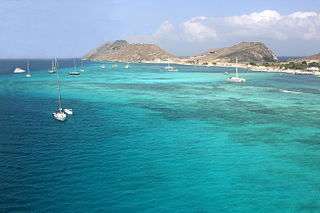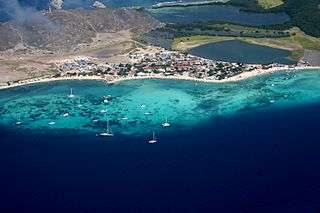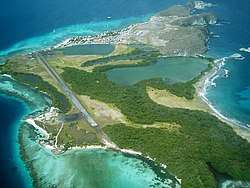Los Roques archipelago
Los Roques archipelago is a federal dependency of Venezuela consisting of approximately 350 islands, cays, and islets in a total area of 40.61 square kilometers. The archipelago is located 128 kilometers (80 mi) directly north of the port of La Guaira, in the Caribbean Sea.
| Native name: Dependencia Federal Archipiélago Los Roques Nickname: Los Roques | |
|---|---|
  _de_los_Roques_Venezuela_000.jpg)   | |
.jpg) Los Roques Archipiélago  Los Roques Archipiélago | |
| Geography | |
| Location | Caribbean Sea |
| Coordinates | 11°51′27″N 66°45′27″W |
| Total islands | 350 |
| Major islands | Cayo Grande |
| Area | 40.61 km2 (15.68 sq mi) |
| Administration | |
| Largest settlement | Gran Roque |
| Demographics | |
| Population | 3,100 (2014) |
| Pop. density | 44.32/km2 (114.79/sq mi) |
| Official name | Parque Nacional Archipiélago Los Roques |
| Designated | 4 September 1996 |
| Reference no. | 856[1] |
The islands' pristine coral reef attracts many wealthy visitors, especially from Europe, some of whom come in their own yachts and anchor in the inner, protected shallow waters. Development and tourism are controlled.
Because of the wide variety of seabirds and rich aquatic life, the Venezuelan government declared Los Roques a National Park in 1972.[2]
History
The islands were sighted by early European navigators, and in 1589 the governor of the Venezuelan province ordered the formal takeover of these islands on behalf of the colony.
The Dutch considered Los Roques to belong to their island territory of Curaçao because of its proximity to Bonaire which also belonged to the Dutch. The author M.D. Teenstra in 1836 still writes (in his book The Dutch West Indies): "The Government of Curaçao also includes the uninhabited islets and rocks Little Curaçao, Aves, Roques and Orchilla."
In the 18th century, the Sociedad Mercantil Real Compañía Guipuzcoana was established on the islands and the first islands of the archipelago (Gran Roque, Carenero, Cayo Sal, etc.) were given their names. Also at that time, temporary fishermen began to arrive, and in the 19th century the exploitation of salt mines and guano began.
In 1871 the Venezuelan president Antonio Guzmán Blanco created by decree the Territorio Colón (Columbus Territory) which included Los Roques and other adjacent islands. The island of Gran Roque was named as the center of territorial government.
Around the year 1886 there is reference to the arrival of inhabitants coming from the nearby Netherlands Antilles, Aruba, Curaçao, etc. They left as a legacy some of the exotic names given to some islands or keys (for example Francisquí, Madrisquí, Krasquí, Selesquí). The suffix "quí" corresponds to the English term (and other languages) "key", which means key.
At the beginning of the 20th century an epidemic of bubonic plague in La Guaira caused the Venezuelan government to authorize the use of the island of Gran Roque as a quarantine site.
In 1910, the town of Gran Roque began to consolidate with families from Margarita Island, mainly fishermen.
On July 20, 1938 the islands were integrated into the Federal Dependencies of Venezuela, and it was only on August 8, 1972 when the archipelago was declared a national park.

In 1978 the marine delimitation agreement between Venezuela and the Kingdom of the Netherlands is signed.
In order to give greater dynamism to its administration and promote the sustainable development of the islands on November 2, 1990, according to Presidential Decree 1214, the figure of the Single Authority of Los Roques Area was created, which would continue as part of the Federal Dependencies but with a special administrative status.
In October 2011 all the islands of the Los Roques archipelago are integrated to the Miranda Island Territory according to presidential decree 8549 of November 1, 2011, published in the official gazette N° 39797, a subdivision of the Federal Dependencies with capital in Gran Roque.
In 2012 the Bolivarian Navy of Venezuela named a Damen Stan Lander 5612 landing craft after the islands.[3]
Geography
The major islands of the archipelago have an atoll structure, with two external barriers formed by coral communities, and an inner lagoon and sandy shallows. The park consists of 40.61 km2 (15.68 sq mi), 1,500 km2 (580 sq mi) of coral reefs, 42 coral cays surrounding a shallow central lagoon of 400 km2 (150 sq mi), two barrier reefs (24 km (15 mi) east and 32 km (20 mi) south) and 300 sand banks, islands and cays, ranging in size from Cayo Grande (15.1 km2 (5.8 sq mi)) to the Gran Roque (1.7 km2 (0.66 sq mi)).[4][5][6] Other important islands are Francisqui, Nordisqui, Madrisqui, and Crasqui.
Demographics
The archipelago is sparsely populated, having about 1,500 permanent inhabitants; however it receives approximately 70,000 visitors a year, many of them day-visitors who come from Caracas and the mainland.
The population of the Roques concentrates mainly on the island of Gran Roque and to a lesser extent its adjacent islets. In 1941, the population was estimated at about 484 people. In 1950 it reached 559, and in 1987 663 permanent inhabitants. According to the Venezuelan census of 2001 1,209 inhabitants were counted. By 2008 it is estimated that the number inhabitants to be around 1,800.
Its growth is limited because of restrictions involving the declaration as a national park in the 1970s. Most of the population is of Margariteño origin who came to the islands mainly to engage in fishing. Since the early twentieth century there has been a small influx of foreigners (mostly Italian).
Climate
The climate is warm and dry, with average annual temperature of 27.3 °C (81.1 °F) in July and August, reaches a maximum of 34 °, and between September and January are presented occasional rain, with relative humidity 83% annually. Rainfall is 256.6 mm (10.10 in) / year; minimum 6.6 mm (0.26 in) (April) and maximum 52.2 mm (2.06 in) (November).
Government
Los Roques is a Federal Dependency that is administered directly by officials appointed by the central or federal government of Venezuela.
Between 1990 and 2011 the central government appointed a director for the Single Area Authority (Autoridad Única de Área) within the Federal Dependencies, but that last year the central government created the figure of the Miranda Insular Territory (Territorio Insular) that encompasses not only Los Roques but La Orchila and Las Aves Archipelago.
The headquarters of the head of government (Jefe de Gobierno) of the insular territory is the island of Gran Roque to the north of the Los Roques Archipelago.
Additionally in the island there are dependencies of other public organisms such as Inparques (National Parks Institute) since the archipelago is a national park and the National Guard of Venezuela (Guardia Nacional).
Tourism
Infrastructure
El Gran Roque is the only populated island in the group. It has an airport suitable for small or STOL aircraft, Los Roques Airport. The airport is controlled from the Maiquetía airport on the mainland.
From El Gran Roque most visitors that arrive, go to the port and travel to the keys in small boats called "peñeros" from 9:00 am to 4:00 pm.[7]
Attractions

Activities include fishing (bonefish, barracuda, tarpon, jack, and Spanish mackerel), birding, snorkeling, diving, paddling, windsurfing, and kitesurfing, and there is a sea turtle research center located on Dos Mosquises. Accommodations include Pez Raton Lodge, a property primarily used to host fishing guests, Posada Mediterraneo, a five-room inn which accommodates non-fishing guests, and dozens more like El Canto de la Ballena and Posada La Gaviota.
See also
- Federal Dependencies of Venezuela
- List of national parks of Venezuela
- List of marine molluscs of Venezuela
- List of Poriferans of Venezuela
References
- "Parque Nacional Archipiélago Los Roques". Ramsar Sites Information Service. Retrieved 25 April 2018.
- Instituto Nacional de Parques (INPAQUES). Archipiélago de Los Roques. "Archived copy". Archived from the original on 2008-04-24. Retrieved 2013-02-27.CS1 maint: archived copy as title (link)
- "US donated Patrol boats to Panama's Servicio Nacional Aeronaval". New Delhi Times. 2018-11-14. Retrieved 2019-04-15.
- Vila, Marco Aurelio. 1967: Aspectos geográficos de las Dependencias Federales. Corporación Venezolana de Fomento. Caracas. 115p.
- Cervigon, Fernando. 1995: Las Dependencias Federales. Academia Nacional de la Historia. Caracas. 193p.
- Hernández Caballero, Serafín (Editor). 1998: Gran Enciclopedia de Venezuela. Editorial Globe, C.A. Caracas. 10 volúmenes. ISBN 980-6427-00-9 ISBN 980-6427-10-6
- http://www.eluniversal.com/guia-turistica/150531/los-roques
External links
| Wikivoyage has a travel guide for Los Roques. |
| Wikimedia Commons has media related to Los Roques archipelago. |
(in Spanish) National Park Institute, Venezuela
_de_los_Roques_Venezuela_001.jpg)